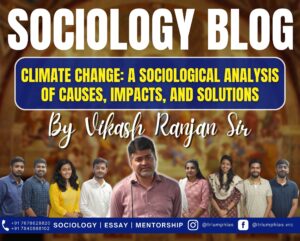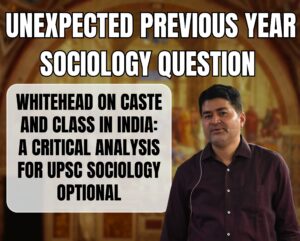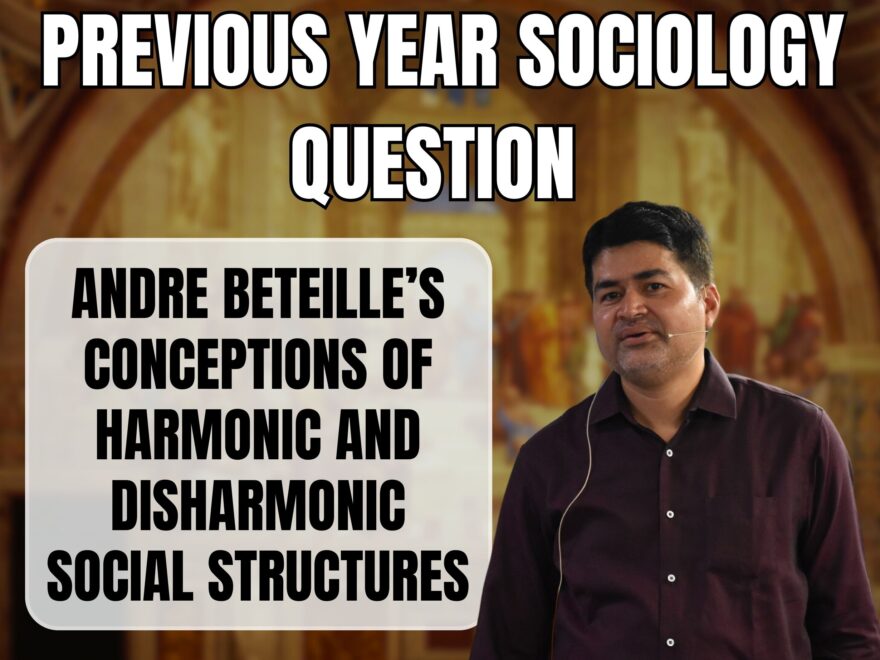In the Context of Changing Indian Society, How do You View Andre Beteille’s Conceptions of Harmonic and Disharmonic Social Structures?
(Paper: 2, Section- A, Year 2022, Unit 12: Caste System)
|
Introduction: Basic About Harmonic and Disharmonic Social Structure Main Body: Explanation of Harmonic and Disharmonic Social Structure, Examples for the Same in Various Social Institutions Conclusion: Significance of Harmonic and Disharmonic System in Solving Social Issues |
In the Context of Changing Indian Society, How do You View Andre Beteille’s Conceptions of Harmonic and Disharmonic Social Structures?
(10 Marks)

Introduction of the Answer
André Béteille, a prominent Indian sociologist, introduced the concepts of “harmonic” and “disharmonic” societies to analyse and understand the dynamics of social life and relationships within different communities. These concepts are used to describe the level of coordination and coherence in various aspects of a society’s structure and functioning.
Main Body of the Answer
Harmonic Society:
- In Béteille’s terminology, a “harmonic society” is characterized by a high degree of integration and coherence among its various components.
- In such a society, there is a relatively smooth alignment between different social institutions, roles, norms, and values. This alignment leads to stability, social order, and a sense of unity among its members.
- Harmonic societies tend to have well-defined hierarchies, roles, and a shared cultural consensus.
- For instance, traditional rural societies with clear-cut divisions of labor, roles, and responsibilities can be considered harmonic. In these societies, people generally follow established norms and practices, and there is a relatively low degree of conflict or deviation from the norm.
Disharmonic Society:
- Conversely, a “disharmonic society” is characterized by fragmentation, contradictions, and conflicts among different social elements.
- In such societies, there is a lack of coherence and coordination, leading to tensions, disputes, and social instability
- . Disharmonic societies often experience clashes between different groups or interests due to divergent norms, values, and interests.
- Modern urban societies with their complex networks of relationships, diverse values, and multiple roles can exhibit characteristics of disharmony. In these societies, there might be conflicts arising from differing cultural backgrounds, competing ideologies, and varying socio-economic interests.
André Béteille’s conception of “harmonic” and “disharmonic” social structures offers valuable insights into understanding the complexities of transformation and continuity within the country’s social fabric:
- Caste system :
- Harmonic Aspects of the Changing Caste System:
- Preservation of Cultural Norms: In certain contexts, the caste system has maintained a sense of cultural continuity and identity. Traditional practices, rituals, and customs associated with different castes contribute to a sense of harmony and cultural cohesion within these communities.
- Social Roles and Stability: Historically, the caste system provided a structured division of labour, contributing to a harmonious coexistence among various castes. Each caste had defined roles and responsibilities, leading to a stable social order.
- Social Integration: The caste system facilitated social integration within localized communities. Castes often acted as social support networks, fostering cooperation and mutual assistance among members.
- Disharmonic Aspects of the Changing Caste System:
- Erosion of Traditional Boundaries: With urbanization and increased mobility, traditional caste-based divisions are becoming less relevant. This erosion of traditional boundaries can lead to a breakdown of the harmonious division of labor and social roles. Caste based Positive affirmative steps have created disharmony which is visible in demands of reservation from different castes in society and leading conflicts.
- Relative Deprivation: As India modernizes, economic disparities are becoming more pronounced across caste lines. Certain castes have been historically marginalized, and the uneven distribution of resources can lead to social tensions and conflicts. This has led to politicisation of caste and blurring lines between modern political system and traditional caste systems. Rajani Kothari highlights it as phenomenon of“ caste in politics and politics in caste”
- Cultural Clash: Urbanization and exposure to diverse ideas can lead to cultural clashes between traditional caste norms and modern values. Younger generations might reject certain caste-based practices, causing internal tensions within families and communities. Inter caste marriage is disharmonic aspect of cultural clash.
- Changing Family Structure
- Harmonic Analysis: Harmonic aspect involves providing primary socialization, financial support and adult personality stabilization, fulfilling ritual obligations and intergenerational relations and kinship support which results in social cultural capital.
- Disharmonic Aspects: there is simultaneous existence of traditional and modern family structures. This creates disharmony for examp0le a person when migrates for economic opportunities, he may get involved in liv in relationship, which creates conflict with traditional norm of marriage based family. Similarly new institutions like double income no kid, and bit parents working family where child become emotional scapegoats are disharmonic aspects of changing dynamics of family.
Changing Gendered Division of Labour
-
-
- Harmonic analysis of entry of women in instrumental roles: It has allowed women empowerment. which has positive implication of entitlements of women related to health a, nutrition , decision making in matters of kid, self-actualisation and breaking shackles of regressive patriarchal oppression like domestic violence etc.
- Disharmonic aspect: the double shift due to legged adaptation , sexual harassments at workplace, glass ceiling , gender wage pay disparity and hampered socialization of kids are some conflicting disharmonic aspects of change in gendered division of labour.
-
Some other disharmonic aspect of changing social dynamics:
Disharmony in Rural Areas: In rural areas, a lack of accessible choices for achieving mobility still persists, limiting the opportunities available to the rural population.
Disharmony in Education: A significant disparity exists between the quality of education provided by private schools compared to public schools.
Disharmony in Religion: While India’s society historically embraced secularism and the principle of ‘sarva dharma sambhava’, the Sachar Committee’s report highlights that Muslims face comparatively lower levels of development compared to other religious communities.
Disharmony in Tribal Development: The policy of tribal panchsheel, aimed at integrating tribes while preserving their cultural identity, has not effectively prevented the displacement of tribal communities, leading to imbalances in development.
Disharmony in Economy: Despite India adopting a mixed economy growth model since 1991, government policies sometimes favour specific industrialists over others during the distribution of tenders, resulting in an imbalance in economic opportunities
Disharmony in Environment: Although India aims to achieve a 50% energy mix from renewable sources by 2030; it remains the largest coal importer globally, with coal still constituting 55% of its energy consumption
Disharmony in Social Inclusion: While the Indian constitution guarantees equality for all, the persistent practice of untouchability remains a stain on the nation’s commitment to social harmony.
Conclusion of the Answer
- André Béteille’s concepts of harmonic and disharmonic social structures offer profound insights into the intricate dynamics of societal transformation. His framework highlights the intricate interplay between integration and fragmentation within various dimensions of society.
- The traditional caste system, evolving family structures, shifting gender roles, and wider societal disparities all illustrate the simultaneous presence of both harmonious and discordant elements.
- This duality underscores the complexity of navigating societal change. Addressing these disharmonic aspects requires a concerted effort to promote inclusivity, equitable opportunities, and cultural understanding. Beteille’s concepts serve as a valuable guide in forging a more balanced and cohesive path toward progress and social harmony in India.
Related Blogs …
 |
 |

To master these intricacies and fare well in the Sociology Optional Syllabus, aspiring sociologists might benefit from guidance by the Best Sociology Optional Teacher and participation in the Best Sociology Optional Coaching. These avenues provide comprehensive assistance, ensuring a solid understanding of sociology’s diverse methodologies and techniques.
META TAGS:
André Béteille, Harmonic Societies, Disharmonic Societies, Social Change, India, Caste System, Family Structure, Gender Roles, Rural Development, Education, Religion, Social Inclusion, disharmonic society, Harmonic Analysis, Disharmonic Aspects, sarva dharma sambhava, Relative Deprivation, Cultural Clash, Erosion of Traditional Boundaries,
Why Vikash Ranjan’s Classes for Sociology?
Proper guidance and assistance are required to learn the skill of interlinking current happenings with the conventional topics. VIKASH RANJAN SIR at TRIUMPH IAS guides students according to the Recent Trends of UPSC, making him the Best Sociology Teacher for Sociology Optional UPSC.
At Triumph IAS, the Best Sociology Optional Coaching platform, we not only provide the best study material and applied classes for Sociology for IAS but also conduct regular assignments and class tests to assess candidates’ writing skills and understanding of the subject.
Choose The Best Sociology Optional Teacher for IAS Preparation?
At the beginning of the journey for Civil Services Examination preparation, many students face a pivotal decision – selecting their optional subject. Questions such as “which optional subject is the best?” and “which optional subject is the most scoring?” frequently come to mind. Choosing the right optional subject, like choosing the best sociology optional teacher, is a subjective yet vital step that requires a thoughtful decision based on facts. A misstep in this crucial decision can indeed prove disastrous.
Ever since the exam pattern was revamped in 2013, the UPSC has eliminated the need for a second optional subject. Now, candidates have to choose only one optional subject for the UPSC Mains, which has two papers of 250 marks each. One of the compelling choices for many has been the sociology optional. However, it’s strongly advised to decide on your optional subject for mains well ahead of time to get sufficient time to complete the syllabus. After all, most students score similarly in General Studies Papers; it’s the score in the optional subject & essay that contributes significantly to the final selection.
“A sound strategy does not rely solely on the popular
Opinion of toppers or famous YouTubers cum teachers.”
It requires understanding one’s ability, interest, and the relevance of the subject, not just for the exam but also for life in general. Hence, when selecting the best sociology teacher, one must consider the usefulness of sociology optional coaching in General Studies, Essay, and Personality Test.
The choice of the optional subject should be based on objective criteria, such as the nature, scope, and size of the syllabus, uniformity and stability in the question pattern, relevance of the syllabic content in daily life in society, and the availability of study material and guidance. For example, choosing the best sociology optional coaching can ensure access to top-quality study materials and experienced teachers. Always remember, the approach of the UPSC optional subject differs from your academic studies of subjects. Therefore, before settling for sociology optional, you need to analyze the syllabus, previous years’ pattern, subject requirements (be it ideal, visionary, numerical, conceptual theoretical), and your comfort level with the subject.
This decision marks a critical point in your UPSC – CSE journey, potentially determining your success in a career in IAS/Civil Services. Therefore, it’s crucial to choose wisely, whether it’s the optional subject or the best sociology optional teacher. Always base your decision on accurate facts, and never let your emotional biases guide your choices. After all, the search for the best sociology optional coaching is about finding the perfect fit for your unique academic needs and aspirations.
Follow us :
🔎 https://www.instagram.com/triumphias
🔎https://www.youtube.com/c/TriumphIAS
https://t.me/VikashRanjanSociology
Find More Blogs
|
Scope of the subject and comparison with other social sciences |
|||
|
|
|
|
Modernity and social changes in Europe |

